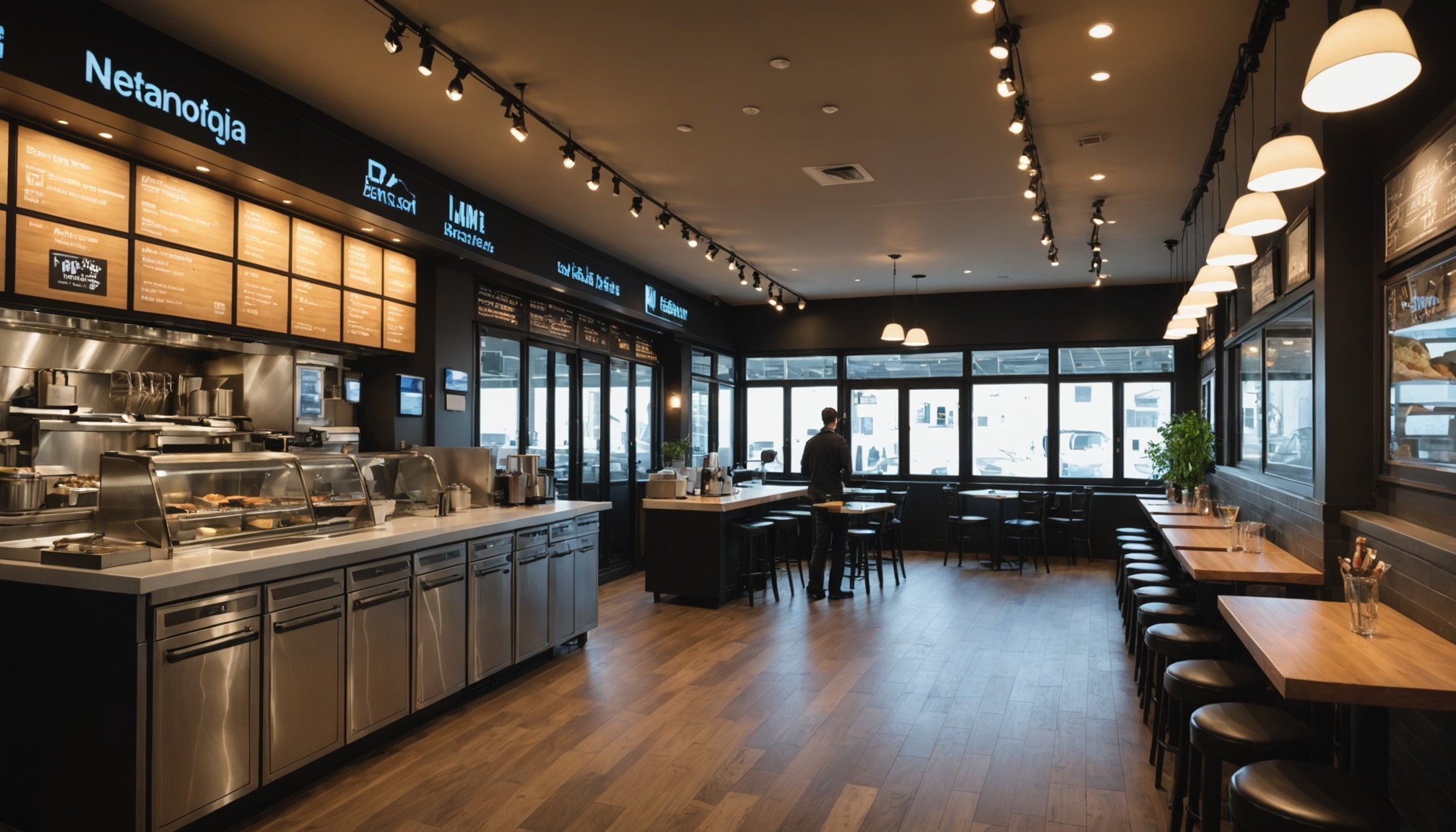Practical Tips for Adopting IoT Solutions
Adopting IoT solutions in restaurant inventory management can revolutionize operations and drive restaurant efficiency. To smoothly navigate IoT adoption, it’s crucial to start by assessing current inventory management processes. This involves identifying areas where Internet of Things (IoT) technology could address inefficiencies and enhance accuracy.
IoT adoption requires selecting the right IoT tools or platforms that suit specific operational needs. When choosing these tools, consider features that offer real-time data collection, alerts for inventory shortages, and integration capabilities with existing systems. It’s beneficial to choose solutions that are scalable, accommodating the unique demands of multi-site management.
Have you seen this : Revamping Family Meals: Discover the Magic of Interactive Tabletop Games
Training staff is another critical step. Employees must understand how to operate new systems and interpret the data provided. This can involve hands-on training sessions, workshops, and ongoing support to help staff become comfortable with the transition and to maximise benefits achieved through advanced technology.
Integrating IoT systems into daily operations can transform processes, making them more streamlined and responsive. Establish robust protocols for using the new technology, and continuously monitor its impact on inventory levels and waste reduction. This approach ensures that your decision to adopt IoT is supported by favourable outcomes in both productivity and cost savings.
Topic to read : Transform Your Restaurant Menu: Unlock Unmatched Flavors with Locally Sourced Ingredients
Introduction to IoT in Restaurant Inventory Management
The role of IoT technology in restaurant inventory management is transformative, offering unparalleled advantages like enhanced efficiency and operational fluidity. By incorporating IoT into inventory systems, restaurants can shift from reactive to proactive management, effectively tackling shortages and overstock issues. Utilizing sensors and smart devices, IoT aids in real-time tracking of stocks, promoting swift decision-making and maintaining optimal inventory levels.
Efficiency is paramount, especially in multi-site restaurant management. IoT facilitates cohesive operations across multiple locations by standardizing processes and visibility. This helps in synchronizing inventory updates and orders, which minimizes misunderstandings and errors. As the system continuously tracks and records data, it alerts managers to consumption trends and potential discrepancies, enabling more informed decisions.
Moreover, IoT technology enhances inventory processes by offering a clear, comprehensive overview of supply chains. This transparency ensures that restaurants are always informed about the exact movement and current status of their inventories, significantly reducing the margin for error. Additionally, the detailed data provided by IoT helps refine forecasting methods, ensuring restaurants are better prepared for fluctuations in supply and demand. By leveraging these insights, operators can streamline their processes and, ultimately, boost their restaurant’s efficiency.
IoT Technology Applications in Restaurant Inventory
Implementing IoT technology in restaurant inventory management involves the use of numerous smart devices, each designed for specific tasks. These devices are essential in inventory tracking, capturing real-time data to offer managers a live update of stock levels. Real-time data collection allows for immediate analysis, enabling quick adjustments to avoid overstock or shortages.
Smart devices used in these systems often include temperature and humidity sensors, RFID tags, and automatic restocking triggers. Each tool plays a crucial role in precision and efficiency, helping to reduce human error and streamline processes. The automation provided by these technologies supports operational consistency, especially in multi-site operations where maintaining uniformity across locations is vital.
Moreover, the benefits of integrating IoT smart devices extend beyond data accuracy. They enhance supply chain transparency by providing a continuous overview from supplier to storage. This transparency significantly reduces loss due to spoilage or theft, resulting in substantial cost savings and waste reduction. Ultimately, the precision and accuracy delivered by IoT smart devices elevate the overall efficiency of restaurant inventory systems, making them indispensable assets in modern restaurant management.
Potential Challenges in IoT Adoption
Embracing IoT technology in restaurant operations can elevate efficiency, but it comes with its own set of challenges. One of the primary IoT adoption barriers is the initial cost of investment. Installing IoT devices like sensors and smart tags requires a significant upfront expenditure, which may deter smaller establishments.
Security concerns represent another substantial hurdle. As IoT systems gather vast amounts of data, safeguarding this information becomes crucial. Potential breaches can lead to data theft or mismanagement, threatening both customer and proprietary information. Restaurants must invest in robust security protocols to protect sensitive data.
Data privacy issues are also prominent in discussions around IoT adoption. With the continuous collection of data, ensuring compliance with privacy regulations is essential. Restaurants need to be transparent about data collection practices and obtain the necessary consents.
Furthermore, understanding the return on investment (ROI) in IoT solutions can be challenging. Calculating the benefits in terms of cost savings versus the initial and ongoing expenses requires careful analysis. Overcoming these barriers demands a strategic approach, where restaurants consider long-term operational gains and partner with knowledgeable IoT technology providers. By addressing these challenges carefully, restaurants can maximise the benefits while mitigating potential risks.
Case Studies of Successful Implementations
Successful IoT implementations offer a blueprint for restaurants looking to optimise their inventory management. High-profile restaurant chains like McDonald’s and Starbucks have adopted IoT technology to enhance efficiency. These chains utilise smart devices to track inventory levels and environmental conditions, which reduces waste and aligns stock with customer demand. As a result, they’ve observed increased operational efficiencies, lower costs, and improved service speed.
High-Profile Restaurant Chains
These chains have seen significant results through IoT adoption:
- McDonald’s has reported a 10% reduction in waste.
- Starbucks has synced its supply chain activities across locations, improving inventory accuracy.
Lessons learned emphasize the importance of comprehensive staff training, ensuring team members are comfortable with new technology, which facilitates smoother transitions.
Independent Restaurants Implementing IoT
Independent restaurants, though smaller, have also reaped operational efficiency benefits from IoT. For example, a local café chain saw a 15% cut in spoilage costs by implementing real-time inventory tracking. Testimonials from owners highlight increased customer satisfaction, as products are regularly available. These successes illustrate the power of precise tracking and targeted investments in IoT. Independent operators have found that even on a smaller scale, the use of IoT devices can transform operations and enhance profitability.
Supporting Data and Statistics
IoT statistics provide compelling evidence of the technology’s transformative impact on restaurant efficiency and inventory management. Data reveals that IoT adoption can lead to a 30% reduction in inventory-related labour costs by automating tracking and reporting tasks. This automation not only saves time but also improves accuracy, leading to streamlined operations.
Moreover, IoT technology has been shown to enhance restaurant efficiency by lowering food waste by up to 20%. Through real-time monitoring of stock levels and environmental conditions, restaurants can adjust orders promptly, aligning stock with demand and significantly minimising spoilage. This proactive approach fosters a more sustainable operation.
A study highlights that multi-site restaurants leveraging IoT experience 25% better inventory accuracy across locations. This coherence is made possible through integrated systems that synchronise data, ensuring replicas of inventory information across all sites. Such consistency is crucial for maintaining quality and customer satisfaction.
As IoT innovations continue to evolve, trends show an increasing number of restaurateurs adopting these solutions—40% of restaurant operators plan to implement IoT technologies within the next two years. The emphasis on data gathering and analysis supports more informed decision-making, driving future strategies for enhanced operational efficiencies.
Recommendations for Tools and Platforms
The selection of appropriate IoT tools and inventory platforms is vital for restaurant operators aiming to optimize efficiency. In the realm of inventory management, several leading IoT solutions stand out for their robust features.
-
Zebra Technologies offers RFID-enabled solutions that facilitate real-time data tracking, ensuring precise inventory updates. This platform integrates seamlessly with existing systems, making it a favourite among large chains for its ease of use and accurate tracking capabilities.
-
Oracle’s Cloud SCM provides advanced analytics and comprehensive visibility across the supply chain, ideal for multi-site management. Its forecasting tools help predict inventory needs, reducing both waste and overstock risks.
When comparing features, consider platforms like SAP IoT, renowned for its ability to provide real-time analytics and actionable insights, or IoTium, which excels in secure data transfer across connected devices.
Selecting the best technology fit requires evaluating restaurant-specific needs, such as the size of operations and budget constraints. It is advisable to trial options, assessing integration capabilities and ensuring scalability for future expansions. By aligning IoT technology choices with operational goals, restaurants can unlock greater efficiency and enhance profitability.
Benefits of IoT Innovations in Inventory Management
IoT innovations transform inventory management, offering substantial cost savings by optimizing inventory levels. By ensuring precise tracking, IoT technologies significantly reduce the risk of overstock or understock situations. This precision means restaurants can maintain ideal stock levels, resulting in reduced holding costs and savings for businesses.
A prime advantage of IoT adoption is the reduction in food waste and spoilage. By leveraging real-time monitoring tools, restaurants promptly adjust orders to match actual demand, minimizing the chance of spoilage. This approach not only reduces waste but also supports a more sustainable operation, aligning with environmentally conscious consumer expectations.
Implementing IoT solutions enhances operational efficiencies, contributing to improved profit margins. As IoT systems automate many inventory tasks, like tracking and reordering, restaurant staff can focus on value-adding activities, ensuring seamless service and higher customer satisfaction. Ultimately, the streamlined operations facilitated by IoT lead to cost-effective processes and increased profitability.
The tangible benefits of IoT in inventory management empower restaurants to compete effectively, offering a solid return on their technology investment. Better resource management, coupled with reduced waste and optimized efficiency, makes IoT an indispensable tool in modern inventory practices.











